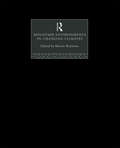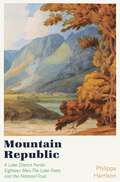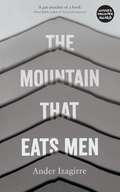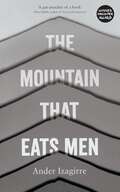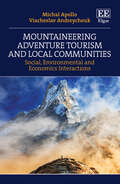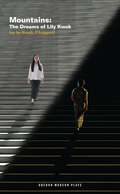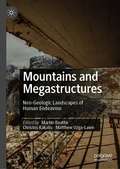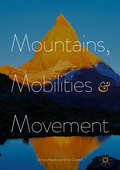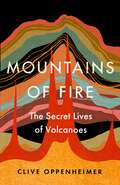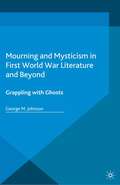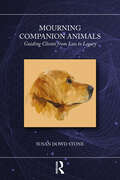- Table View
- List View
Mountain Environments in Changing Climates
by Martin BenistonHome to large numbers of people, sources of water, centres of tourism, and sensitive ecological zones, mountain environments share distinctive climactic characteristics. Once regarded as economically non-viable regions, mountains now attract major investment as sites of tourism, hydro-power and communication routes. This book brings together some of the current work on the physical and human ecology of mountain environments, the impacts of climate change, the processes involved and their observation and prediction.
MOUNTAIN GEOMORPHOLOGY
by Phil Owens Olav SlaymakerMountains represent one of the most inspiring and attractive natural features on the surface of the earth. Visually, they dominate the landscape. However, the increasing realization of the fragility of mountain areas because of changes in land use, management and climate, combined with an understanding of their importance for water and other natural resources, has resulted in a growing interest in mountain environments in recent years. Hence, Mountain Geomorphology represents a timely and unique contribution to the literature. Written by a team of international experts, this book is divided into three sections, which consider historical, functional and applied mountain geomorphology from both global and local perspectives. Historical mountain geomorphology focuses on the evolution of landforms. Functional mountain geomorphology emphasises the interaction between processes and landforms, while applied mountain geomorphology concerns the interrelationships between geomorphological processes and society. Mountain Geomorphology is a valuable source of information for students studying mountain geomorphology, and also for academics and research scientists interested in mountain environments.
MOUNTAIN GEOMORPHOLOGY
by Phil Owens Olav SlaymakerMountains represent one of the most inspiring and attractive natural features on the surface of the earth. Visually, they dominate the landscape. However, the increasing realization of the fragility of mountain areas because of changes in land use, management and climate, combined with an understanding of their importance for water and other natural resources, has resulted in a growing interest in mountain environments in recent years. Hence, Mountain Geomorphology represents a timely and unique contribution to the literature. Written by a team of international experts, this book is divided into three sections, which consider historical, functional and applied mountain geomorphology from both global and local perspectives. Historical mountain geomorphology focuses on the evolution of landforms. Functional mountain geomorphology emphasises the interaction between processes and landforms, while applied mountain geomorphology concerns the interrelationships between geomorphological processes and society. Mountain Geomorphology is a valuable source of information for students studying mountain geomorphology, and also for academics and research scientists interested in mountain environments.
Mountain Hazards and Disaster Risk Reduction (Disaster Risk Reduction)
by Hari Krishna Nibanupudi Rajib ShawThe Hindu Kush Himalayan (HKH) region is highly vulnerable to earthquakes and water-induced disasters. This fragile mountain region is under tremendous stress from climate change and land-use degradation that has accelerated flash floods, river-line floods, erosion, and wet mass movements during the monsoon period and drought in the non-monsoon period. Against the backdrop of intensifying disasters and in the absence of a focused documentation of disaster risk reduction issues in the HKH region, this volume presents a comprehensive body of knowledge. The main purpose and objective of this publication is to connect existing data, research, conceptual work, and practical cases on risk, resilience, and risk reduction from the HKH region under a common analytical umbrella. The result is a contribution to advancing disaster resilience and risk reduction in the HKH region. The book will be of special interest to policy makers, donors, and researchers concerned with the disaster issues in the region.
Mountain Republic: A Lake District Parish - Eighteen Men, The Lake Poets and the National Trust
by Philippa HarrisonAn affectionate but meticulously researched history of one of the most beautiful and best-loved corners of England – Crosthwaite Parish, nestling deep within the mountains and valleys of the Lake District.'A unique contribution to English history' Hunter Davies'A delightful, refreshingly written book, attentive to social detail and telling the only story that matters – history' Simon Jenkins'A wonderful book' Margaret Drabble'A completely fresh perspective on the Lakes and Lake Poets... I hugely enjoyed it' Andrew MarrBounded by the peaks of Scafell, Skiddaw and Helvellyn, and embracing such well-known landmarks as Borrowdale, Derwentwater and Keswick, it lies within the heart of the Lake Poets' landscape and its rugged terrain excites passion in all those who know it.The Parish also boasts a remarkable history. Its 90 square miles were governed, from medieval times, by eighteen annually chosen 'customary tenants'; ancestors of the people who later prompted Wordsworth's portrayal of the area as 'a perfect Republic of Shepherds and agriculturalists'. His fellow poet Robert Southey lived within the Parish for forty years, was an active parishioner and rests in St Kentigern's churchyard. Here he is given his rightful position as a Lake Poet. In the nineteenth century, the Victorian state killed off the old parish system, sweeping away the egalitarian rule of the Eighteen Men. But a degree of redemption was at hand. Canon Rawnsley, vicar of Crosthwaite from 1883, pledged to defend the Lake District for future generations. So the Parish was at the heart of the creation of the National Trust and blazed a trail for a wider movement to preserve the English landscape.Writing with a historian's rigour and bearing aloft the banner of the Lake District statesmen, Philippa Harrison has produced a magisterial and fascinating record of a parish with a unique social, cultural and aesthetic resonance in English history.
The Mountain that Eats Men
by Ander IzagirreFrom the 16th century, the mines of Potosí, perched high in the Andes, bankrolled the Spanish empire. During those years immense wealth allowed the city to grow larger than London at the time and the mountain was quickly given the epithet Cerro Rico – the 'rich mountain'. But today, Potosí's inhabitants are some of the poorest in South America while the mountain itself has been so greedily plundered that its summit is on the verge of collapsing. So many people have died in the mines that the Cerro Rico is now called the 'mountain that eats men'.In this captivating, moving tale of harrowing bravery and wistful beauty Ander Izagirre tells the story of the mountain and those who risk their lives in its shadow through the eyes of Alicia – a 14-year-old girl working in the dark, dangerous mines to support her family. Through her eyes we can come to know the story of postcolonial Bolivia.
The Mountain that Eats Men
by Ander IzagirreFrom the 16th century, the mines of Potosí, perched high in the Andes, bankrolled the Spanish empire. During those years immense wealth allowed the city to grow larger than London at the time and the mountain was quickly given the epithet Cerro Rico – the 'rich mountain'. But today, Potosí's inhabitants are some of the poorest in South America while the mountain itself has been so greedily plundered that its summit is on the verge of collapsing. So many people have died in the mines that the Cerro Rico is now called the 'mountain that eats men'.In this captivating, moving tale of harrowing bravery and wistful beauty Ander Izagirre tells the story of the mountain and those who risk their lives in its shadow through the eyes of Alicia – a 14-year-old girl working in the dark, dangerous mines to support her family. Through her eyes we can come to know the story of postcolonial Bolivia.
Mountain Witches: Yamauba
by Noriko T. ReiderMountain Witches is a comprehensive guide to the complex figure of yamauba—female yōkai often translated as mountain witches, who are commonly described as tall, enigmatic women with long hair, piercing eyes, and large mouths that open from ear to ear and who live in the mountains—and the evolution of their roles and significance in Japanese culture and society from the premodern era to the present. In recent years yamauba have attracted much attention among scholars of women’s literature as women unconstrained by conformative norms or social expectations, but this is the first book to demonstrate how these figures contribute to folklore, Japanese studies, cultural studies, and gender studies. Situating the yamauba within the construct of yōkai and archetypes, Noriko T. Reider investigates the yamauba attributes through the examination of narratives including folktales, literary works, legends, modern fiction, manga, and anime. She traces the lineage of a yamauba image from the seventh-century text Kojiki to the streets of Shibuya, Tokyo, and explores its emergence as well as its various, often conflicting, characteristics. Reider also examines the adaptation and re-creation of the prototype in diverse media such as modern fiction, film, manga, anime, and fashion in relation to the changing status of women in Japanese society. Offering a comprehensive overview of the development of the yamauba as a literary and mythic trope, Mountain Witches is a study of an archetype that endures in Japanese media and folklore. It will be valuable to students, scholars, and the general reader interested in folklore, Japanese literature, demonology, history, anthropology, cultural studies, gender studies, and the visual and performing arts.
The Mountaineer Site: A Folsom Winter Camp in the Rockies
by Brian N. Andrews David J. Meltzer Mark StigerThe Mountaineer Site presents over a decade’s worth of archaeological research conducted at Mountaineer, a Paleoindian campsite in Colorado’s Upper Gunnison Basin. Mountaineer is one of the very few extensively excavated, long-term Folsom occupations with evidence of built structures. The site provides a rich record of stone tool manufacture and use, as well as architectural features, and offers insight into Folsom period adaptive strategies from a time when the region was still in the grip of a waning Ice Age. Contributors examine data concerning the structures, the duration and repetition of occupations, and the nature of the site’s artifact assemblages to offer a valuable new perspective on human activity in the Rocky Mountains in the Late Pleistocene. Chapters survey the history of fieldwork at the site and compare and explain the various excavation procedures used; discuss the geology, taphonomic history, and geochronology of the site; analyze artifacts and other recovered materials; examine architectural elements; and compare the present and past environments of the Upper Gunnison Basin to gain insight into the setting in which Folsom groups were operating and the resources that were available to them. The Folsom archaeological record indicates far greater variability in adaptive behavior than previously recognized in traditional models. The Mountaineer Site shows how accounting for reduced mobility, more generalized subsistence patterns, and variability in tool manufacture and use allows for a richer and more accurate understanding of Folsom lifeways. It will be of great interest to graduate students and archaeologists focusing on Paleoindian archaeology, hunter-gatherer mobility, lithic technological organization, and prehistoric households, as well as prehistorians, anthropologists, and social scientists. Contributors: Richard J. Anderson, Andrew R. Boehm, Christy E. Briles, Katherine A. Cross, Steven D. Emslie, Metin I. Eren, Richard Gunst, Kalanka Jayalath, Brooke M. Morgan, Cathy Whitlock
Mountaineering Adventure Tourism and Local Communities: Social, Environmental and Economics Interactions
by Michal Apollo Viacheslav AndreychoukThis timely book explores how hiking, trekking and climbing mountains, increasingly popular leisure activities, can stimulate change and create opportunities for sustainable development. Using empirical evidence from interviews held in the Himalayas combined with a theoretical grounding, it focuses on the socio-economic and environmental issues of the impact of mountaineering adventure tourism on local communities.Chapters highlight the progressive stages of the host–guest interactions between local communities and tourists, moving from initial, indirect and final tourism development, and the unique sociocultural phenomena these create. The book examines how, with a planned and systematic approach, mountaineering can be a key factor in promoting an overall improvement in local people’s quality of life through initiatives in economic development and environmental conservation. It offers a look towards the future to create sustainable tourism development in mountain regions.This is an invigorating read for adventure tourism and human geography scholars, particularly with the blend of theory and first-hand studies of local impacts of mountain tourism. It will also be an interesting read for industry representatives, policy makers and professionals in the field.
Mountains: The Dreams Of Lily Kwok (Oberon Modern Plays)
by In-Sook Chappell Helen TseBased on Helen Tse’s bestselling novel Sweet Mandarin, this evocative new play by award-winning writer In-Sook Chappell tells the extraordinary story of the women behind the famous Manchester restaurant. A family held together with one lifeline – food.Helen has grown up in the UK, but always felt a piece of her story was missing. Amidst the skyscrapers and bustling streets of Hong Kong, she meets her grandmother, Lily Kwok, and steps into a past of shocking family secrets that will change her life forever.
Mountains and Megastructures: Neo-Geologic Landscapes of Human Endeavour
by Martin Beattie Christos Kakalis Matthew Ozga-LawnThis book explores the shared qualities of mountains as naturally-formed landscapes, and of megastructures as manmade landscapes, seeking to unravel how each can be understood as an open system of complex network relationships (human, natural and artificial). By looking at mountains and megastructures in an interchangeable way, the book negotiates the fixed boundaries of natural and artificial worlds, to suggest a more complex relationship between landscape and architecture. It suggests an ecological understanding of the interconnectedness of architecture and landscape, and an entangled network of relations. Urban, colonialist, fictional, rural and historical landscapes are interwoven into this fabric that also involves discontinuities, tensions and conflicts as parts of a system that is never linear, but rather fluid and organic as driven by human endeavor.
Mountains, Mobilities and Movement
by Christos Kakalis Emily GoetschThis book explores the moving qualities of mountains by utilising theories, ideas and processes which contribute to a larger understanding of these geological forms. In highlighting the fluid attributes of mountains the authors offer an alternative to the traditional approach of the sciences and the humanities, which address mountains as static geological or geographical features. The essays in this collection posit that movement impacts the relationship between society and mountains – travelling landscape objects, constructing design and artistic translations, climbing and experiencing changing atmospheres and the different ways of seeing from mountain peaks – and that physical, intellectual and spiritual motion is integral to their understanding. This innovative collection will be of great interest to scholars of geography, art, architecture, history, theology and philosophy.
Mountains of Fire: The Secret Lives of Volcanoes
by Clive Oppenheimer'What the French adventurer Jacques Cousteau was to the hidden world under our seas, Oppenheimer is to the hidden, molten world bubbling under our feet.'SUNDAY TIMES'A book that will make all readers want to become volcanologists.'PETER FRANKOPAN'Gripping ... like a thriller ... Oppenheimer is better than good. This is terrific.'SPECTATOR'Beautiful. Mountains of Fire is bursting with poetry, with storytelling. ' WERNER HERZOG__________Volcanoes mean so much more than threat and calamity. Like our parents, they've led whole lives before we get to know them. We are made of the same stuff as the breath and cinders of volcanoes. They have long shaped the path of humanity, provoked pioneering explorations and fired up our imaginations. They are fertile ground for agriculture, art and spirituality, as well as scientific advances, and they act as time capsules, capturing the footprints of those who came before us.World-renowned volcanologist Clive Oppenheimer has worked at the crater's edge in the wildest places on Earth, from remote peaks in the Sahara to mystical mountains in North Korea. His work reveals just how entangled volcanic activity is with our climate, economy, politics, culture and beliefs. From Antarctica to Italy, he paints volcanoes as otherworldly, magical places where our history is laid bare and where nature speaks to something deep within us.Blending cultural history, science, myth and adventure, Mountains of Fire reminds us that, wherever we are on the planet, our stories are profoundly intertwined with volcanoes.
Mountains: Physical, Human-Environmental, and Sociocultural Dynamics
by Mark A. FonstadMountains have captured the interests and passions of people for thousands of years. Today, millions of people live within mountain regions, and mountain regions are often areas of accelerated environmental change. This edited volume highlights new understanding of mountain environments and mountain peoples around the world. The understanding of mountain environments and peoples has been a focus of individual researchers for centuries; more recently the interest in mountain regions among researchers has been growing rapidly. The articles contained within are from a wide spectrum of researchers from different parts of the world who address physical, political, theoretical, social, empirical, environmental, methodological, and economic issues focused on the geography of mountains and their inhabitants. The articles in this special issue are organized into three themed sections with very loose boundaries between themes: (1) physical dynamics of mountain environments, (2) coupled human–physical dynamics, and (3) sociocultural dynamics in mountain regions. This book was first published as a special issue of the Annals of the American Association of Geographers.
Mountains: Physical, Human-Environmental, and Sociocultural Dynamics
by Mark A. FonstadMountains have captured the interests and passions of people for thousands of years. Today, millions of people live within mountain regions, and mountain regions are often areas of accelerated environmental change. This edited volume highlights new understanding of mountain environments and mountain peoples around the world. The understanding of mountain environments and peoples has been a focus of individual researchers for centuries; more recently the interest in mountain regions among researchers has been growing rapidly. The articles contained within are from a wide spectrum of researchers from different parts of the world who address physical, political, theoretical, social, empirical, environmental, methodological, and economic issues focused on the geography of mountains and their inhabitants. The articles in this special issue are organized into three themed sections with very loose boundaries between themes: (1) physical dynamics of mountain environments, (2) coupled human–physical dynamics, and (3) sociocultural dynamics in mountain regions. This book was first published as a special issue of the Annals of the American Association of Geographers.
Mountains: Sources of Water, Sources of Knowledge (Advances in Global Change Research #31)
by Ellen WiegandtThis book addresses the major challenges in assuring globally sustainable water use. It examines critical contemporary and global issues through the lens of global change processes and with a focus on mountain regions. In doing so, it aims to bring state-of-the-art science from numerous disciplines to bear on important environmental and policy questions related to water resources. The volume will be a boon to a range of readers, from environmental scientists to hydrologists.
The Mourning After: Loss and Longing among Midcentury American Men
by John IbsonOn the battlefields of World War II, with their fellow soldiers as the only shield between life and death, a generation of American men found themselves connecting with each other in new and profound ways. Back home after the war, however, these intimacies faced both scorn and vicious homophobia. The Mourning After makes sense of this cruel irony, telling the story of the unmeasured toll exacted upon generations of male friendships. John Ibson draws evidence from the contrasting views of male closeness depicted in WWII-era fiction by Gore Vidal and John Horne Burns, as well as from such wide-ranging sources as psychiatry texts, child development books, the memoirs of veterans’ children, and a slew of vernacular snapshots of happy male couples. In this sweeping reinterpretation of the postwar years, Ibson argues that a prolonged mourning for tenderness lost lay at the core of midcentury American masculinity, leaving far too many men with an unspoken ache that continued long after the fighting stopped, forever damaging their relationships with their wives, their children, and each other.
The Mourning After: Loss and Longing among Midcentury American Men
by John IbsonOn the battlefields of World War II, with their fellow soldiers as the only shield between life and death, a generation of American men found themselves connecting with each other in new and profound ways. Back home after the war, however, these intimacies faced both scorn and vicious homophobia. The Mourning After makes sense of this cruel irony, telling the story of the unmeasured toll exacted upon generations of male friendships. John Ibson draws evidence from the contrasting views of male closeness depicted in WWII-era fiction by Gore Vidal and John Horne Burns, as well as from such wide-ranging sources as psychiatry texts, child development books, the memoirs of veterans’ children, and a slew of vernacular snapshots of happy male couples. In this sweeping reinterpretation of the postwar years, Ibson argues that a prolonged mourning for tenderness lost lay at the core of midcentury American masculinity, leaving far too many men with an unspoken ache that continued long after the fighting stopped, forever damaging their relationships with their wives, their children, and each other.
The Mourning After: Loss and Longing among Midcentury American Men
by John IbsonOn the battlefields of World War II, with their fellow soldiers as the only shield between life and death, a generation of American men found themselves connecting with each other in new and profound ways. Back home after the war, however, these intimacies faced both scorn and vicious homophobia. The Mourning After makes sense of this cruel irony, telling the story of the unmeasured toll exacted upon generations of male friendships. John Ibson draws evidence from the contrasting views of male closeness depicted in WWII-era fiction by Gore Vidal and John Horne Burns, as well as from such wide-ranging sources as psychiatry texts, child development books, the memoirs of veterans’ children, and a slew of vernacular snapshots of happy male couples. In this sweeping reinterpretation of the postwar years, Ibson argues that a prolonged mourning for tenderness lost lay at the core of midcentury American masculinity, leaving far too many men with an unspoken ache that continued long after the fighting stopped, forever damaging their relationships with their wives, their children, and each other.
The Mourning After: Loss and Longing among Midcentury American Men
by John IbsonOn the battlefields of World War II, with their fellow soldiers as the only shield between life and death, a generation of American men found themselves connecting with each other in new and profound ways. Back home after the war, however, these intimacies faced both scorn and vicious homophobia. The Mourning After makes sense of this cruel irony, telling the story of the unmeasured toll exacted upon generations of male friendships. John Ibson draws evidence from the contrasting views of male closeness depicted in WWII-era fiction by Gore Vidal and John Horne Burns, as well as from such wide-ranging sources as psychiatry texts, child development books, the memoirs of veterans’ children, and a slew of vernacular snapshots of happy male couples. In this sweeping reinterpretation of the postwar years, Ibson argues that a prolonged mourning for tenderness lost lay at the core of midcentury American masculinity, leaving far too many men with an unspoken ache that continued long after the fighting stopped, forever damaging their relationships with their wives, their children, and each other.
The Mourning After: Loss and Longing among Midcentury American Men
by John IbsonOn the battlefields of World War II, with their fellow soldiers as the only shield between life and death, a generation of American men found themselves connecting with each other in new and profound ways. Back home after the war, however, these intimacies faced both scorn and vicious homophobia. The Mourning After makes sense of this cruel irony, telling the story of the unmeasured toll exacted upon generations of male friendships. John Ibson draws evidence from the contrasting views of male closeness depicted in WWII-era fiction by Gore Vidal and John Horne Burns, as well as from such wide-ranging sources as psychiatry texts, child development books, the memoirs of veterans’ children, and a slew of vernacular snapshots of happy male couples. In this sweeping reinterpretation of the postwar years, Ibson argues that a prolonged mourning for tenderness lost lay at the core of midcentury American masculinity, leaving far too many men with an unspoken ache that continued long after the fighting stopped, forever damaging their relationships with their wives, their children, and each other.
The Mourning After: Loss and Longing among Midcentury American Men
by John IbsonOn the battlefields of World War II, with their fellow soldiers as the only shield between life and death, a generation of American men found themselves connecting with each other in new and profound ways. Back home after the war, however, these intimacies faced both scorn and vicious homophobia. The Mourning After makes sense of this cruel irony, telling the story of the unmeasured toll exacted upon generations of male friendships. John Ibson draws evidence from the contrasting views of male closeness depicted in WWII-era fiction by Gore Vidal and John Horne Burns, as well as from such wide-ranging sources as psychiatry texts, child development books, the memoirs of veterans’ children, and a slew of vernacular snapshots of happy male couples. In this sweeping reinterpretation of the postwar years, Ibson argues that a prolonged mourning for tenderness lost lay at the core of midcentury American masculinity, leaving far too many men with an unspoken ache that continued long after the fighting stopped, forever damaging their relationships with their wives, their children, and each other.
Mourning and Mysticism in First World War Literature and Beyond: Grappling with Ghosts
by George M. JohnsonThis book traces how iconic writers - including Arthur Conan Doyle, J.M. Barrie, Rudyard Kipling, Virginia Woolf, Wilfred Owen, and Aldous Huxley - shaped their response to the loss of loved ones in the First World War through their embrace of mysticism.
Mourning Companion Animals: Guiding Clients from Loss to Legacy
by Susan Dowd StoneMourning Companion Animals is a guidebook for mental health clinicians searching for effective, compassionate resources to guide their clients through the often-devastating experience of animal companion loss.Chapters offer powerful and comprehensive strategies to heal animal companion loss based in sound, evidenced based, theoretical perspectives. The included author-generated inventory, the animal companion bereavement questionnaire, provides further assistance in clinician exploration of each client’s unique bond with their lost companion.The book’s content is the result of more than twenty-five of extensive work within the human-animal bond, clinical training in the referenced therapies, and application of major psychodynamic theories.
